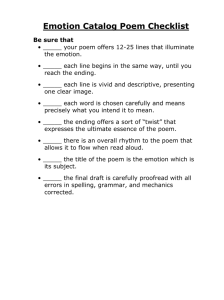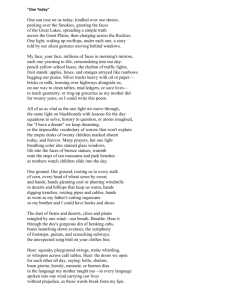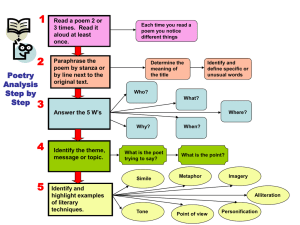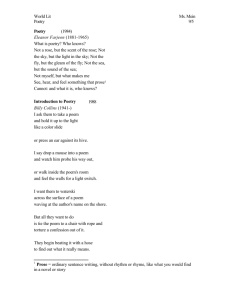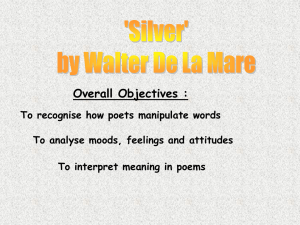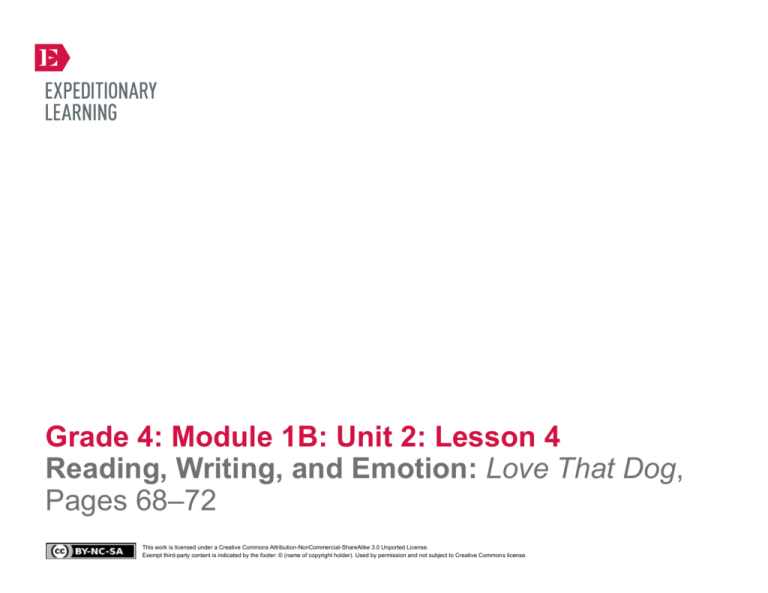
Grade 4: Module 1B: Unit 2: Lesson 4
Reading, Writing, and Emotion: Love That Dog,
Pages 68–72
This work is licensed under a Creative Commons Attribution-NonCommercial-ShareAlike 3.0 Unported License.
Exempt third-party content is indicated by the footer: © (name of copyright holder). Used by permission and not subject to Creative Commons license.
GRADE 4: MODULE 1B: UNIT 2: LESSON 4
Reading, Writing, and Emotion:
Love That Dog, Pages 68–72
Long-Term Targets Addressed (Based on NYSP12 ELA CCLS)
I can explain what a text says, using specific details from the text. (RL.4.1)
I can describe a story’s character, setting, or events using specific details from the text. (RL.4.3)
Supporting Learning Targets
Ongoing Assessment
• I can reflect in writing about my thoughts and feelings after reading “My Sky.”
• What Inspires Jack? graphic organizer
• I can infer why Jack wrote the poem “My Sky.”
• I can respect the feelings of my classmates during a discussion of “My Sky.”
Copyright © 2013 by Expeditionary Learning, New York, NY. All Rights Reserved.
NYS Common Core ELA Curriculum • G4:M1B:U2:L4 • June 2014 •
1
GRADE 4: MODULE 1B: UNIT 2: LESSON 4
Reading, Writing, and Emotion:
Love That Dog, Pages 68–72
Agenda
Teaching Notes
1. Opening
• In this lesson, students read the poem “My Sky” in the book Love That Dog by Sharon Creech. This
poem is likely to affect some students emotionally, because it details the death of Jack’s dog. This lesson
is designed to help students cope with the strong emotions that reading and writing can illicit. For this
reason, the routines of the previous lessons where students read, summarized, and analyzed do not
carry over into this lesson. These routines will pick up again in Lesson 5 as students prepare for a
literary discussion of the text.
A. Reviewing Learning Targets (5 minutes)
2. Work Time
A. Preparing to Read: Writing and Emotion (10
minutes)
B. Reading and Reflection: The Emotional Impact of
“My Sky” (15 minutes)
C. Rereading and Discussion: Why Did Jack Write “My
Sky”? (20 minutes)
3. Closing and Assessment
A. Debrief and Revisiting Learning Targets (10
minutes)
4. Homework
A. Read and summarize pages 73–86 and complete the
Love That Dog summary notes on page 5 of your
reader’s journal.
B. Optional: Think of a time you experienced a strong
feeling such as happiness, sadness, anger, or another
emotion. Write a poem about this experience in the
“My Poems” section of your poetry journal.
• This lesson is intended to give teachers guidance on reading this section of the text with their students.
However, the needs of students should dictate how this lesson unfolds. It is important to support
students’ emotional needs as they read this section of the text; therefore, teachers should use their
professional judgment as they plan their instruction.
• Some students may have read ahead of the class. Consider pulling these students aside in advance and
asking them not to tell the class about the events on s 68–72 in the novel. Explain that it will be
important for everyone to learn about these events through the text first.
• The beginning of this lesson helps to prepare students for the emotional nature of this section of the
text. Then, after the text is read aloud, they are given time to reflect and process their response to the
text in writing. (Some classes and/or students may require more or less time for written reflection.) To
protect students’ privacy and give the class a sense of emotional safety, these reflections are not shared
aloud. After students have time to reflect, they discuss the events outlined in the poem and consider why
the character Jack was moved to write this poem.
• For most of this lesson, students work whole group or individually; however, there will be times when
they talk with a partner. Consider placing students with a partner they know and feel comfortable with.
• Consider students who may find it particularly difficult to read about the death of a pet due to personal
circumstance and seek support of family members or a school counselor.
• In advance: Post the learning targets and Discussion Norms anchor chart.
Copyright © 2013 by Expeditionary Learning, New York, NY. All Rights Reserved.
NYS Common Core ELA Curriculum • G4:M1B:U2:L4 • June 2014 •
2
GRADE 4: MODULE 1B: UNIT 2: LESSON 4
Reading, Writing, and Emotion:
Love That Dog, Pages 68–72
Lesson Vocabulary
Materials
reflect, infer, respect, emotion,
optional
• Poetry journals (students’ own; from Unit 1)
• Love That Dog (book; one per student)
• Reader’s notebook (students’ own; from Unit 1)
– What Inspires Jack? graphic organizer (from pages 20-21 of the reader’s notebook)
• What Inspires Jack? graphic organizer (answers, for teacher reference, from Lesson 3)
• Discussion Norms anchor chart (begun in Unit 1, Lesson 1)
• Discussion Norms anchor chart (with additions for teacher reference)
Copyright © 2013 by Expeditionary Learning, New York, NY. All Rights Reserved.
NYS Common Core ELA Curriculum • G4:M1B:U2:L4 • June 2014 •
3
GRADE 4: MODULE 1B: UNIT 2: LESSON 4
Reading, Writing, and Emotion:
Love That Dog, Pages 68–72
Opening
Meeting Students’ Needs
A. Reviewing Learning Targets (5 minutes)
• Remind students that they began considering what inspires Jack to write poetry in the previous lesson. Tell students that
today they read another poem written by Jack, called “My Sky” and infer why Jack wrote this poem.
• If students have struggled with
respectful discussions in the past,
consider spending more time
discussing the third learning target
in this lesson. Reading stories that
illustrate respecting others’ feelings
or role playing can allow students to
have a clearer picture of this
learning target. Consider talking
with your school counselor for
additional support and guidance in
leading a discussion of this learning
target.
• Call on a few volunteer students to read each of the learning targets aloud to the class:
* I can reflect in writing about my thoughts and feelings after reading “My Sky.”
* I can infer why Jack wrote the poem “My Sky.”
* I can respect the feelings of my classmates during a discussion of “My Sky.”
• Underline the words reflect, infer, and respect. Ask students to turn to a partner and discuss the meaning of each of these
words. Cold call pairs to explain what each of these words means to them.
• Point to the word respect and explain that this word will be especially important in today’s lesson. Ask students:
* “What does it mean to respect someone’s feelings?”
• Listen for students to suggest that this means:
– That you listen without interruption when others are sharing their feelings
– That you do not laugh or use sarcasm when someone is sharing how he or she feels.
– Not asking insensitive questions when someone does not want to share his or her feelings.
• Tell students that “My Sky” is a sad poem and that it will be important to respect the feelings of their classmates during this
lesson. Ask students to give specific examples of what respecting the feelings of others might look or sound like.
Copyright © 2013 by Expeditionary Learning, New York, NY. All Rights Reserved.
NYS Common Core ELA Curriculum • G4:M1B:U2:L4 • June 2014 •
4
GRADE 4: MODULE 1B: UNIT 2: LESSON 4
Reading, Writing, and Emotion:
Love That Dog, Pages 68–72
Work Time
Meeting Students’ Needs
A. Preparing to Read: Writing and Emotion (10 minutes)
• Consider talking with your school
counselor for additional support
and guidance in leading the
discussion during this portion of the
lesson.
• Ask students to get out their poetry journals and partner up.
• Ask them to brainstorm and record words that describe powerful emotions on a new page in the “Vivid Words and Phrases”
section of their poetry journals.
• After a minute or two, call on a few pairs to share the words they brainstormed and record them on the board or a piece of
chart paper.
• Listen for words such as: happiness, sadness, fear, and anger. Under students’ list, write additional words used to describe
emotion, such as: frustration, anxiety, joy, excitement, contentment, grief, and confusion.
• Briefly discuss the meaning of unfamiliar words with students and note words that have similar or opposite meanings.
• Tell students that today they will read a poem written by Jack in the novel Love That Dog, called “My Sky.” Explain that this
is a powerfully emotional piece of writing. Go on to explain that it is emotional for two reasons, the first being that Jack is
describing an emotional experience. His emotion is captured in his writing of this poem. Explain that the second reason it is
an emotional piece of writing is because it is likely to evoke strong emotions from those who read it. Tell students that you
would like them to reflect on the following question in writing in the “My Reflections” section of their poetry journal:
* “Describe a time you read something that made you feel a strong emotion. Why do you think writers write about
emotional experiences?”
• Give students 5 minutes for silent reflection.
• Afterward, ask students if there are any volunteers who want to share their reflection with the group. If students do not offer
to share, consider sharing your own reflections on this question.
• Remind students of their discussion and work with the term “inspire” in the previous lesson. Explain that writers can be
inspired by strong emotions. They may want to write about an emotional experience for a variety of reasons, including to
communicate an idea or to send a message to their readers, or even to help themselves understand or process an emotional
event in their lives.
• Tell students that the author Sharon Creech was inspired to describe her character Jack’s emotional experience in the poem
“My Sky.” Explain that she likely knew this poem would evoke strong emotions in her readers, too. Ask students to take a
moment to think about how they will respect the feelings of their classmates after reading this poem.
Copyright © 2013 by Expeditionary Learning, New York, NY. All Rights Reserved.
NYS Common Core ELA Curriculum • G4:M1B:U2:L4 • June 2014 •
5
GRADE 4: MODULE 1B: UNIT 2: LESSON 4
Reading, Writing, and Emotion:
Love That Dog, Pages 68–72
Work Time (continued)
Meeting Students’ Needs
B. Reading and Reflection: The Emotional Impact of “My Sky” (15 minutes)
• It is important to allow students
time to process the emotional
content of the poem “My Sky.” For
some students, this poem may
connect with their personal
experiences with death. For others,
it may be their first encounter with a
text that describes the death of a
beloved pet with such emotional
power.
• Ask students to get out their copies of Love That Dog and turn to page 68. Read the poem “My Sky” aloud as students
follow along in their copies of the text.
• Afterward, if necessary based on the needs of your class, reassure students that feelings of sadness after reading about the
death of a pet are natural. For some, these feelings may be quite strong due to life experience. Explain that writing often
helps people deal with strong emotions and that you would like students to take some time to reflect in writing. Let them
know their writing will not be shared unless they decide to share it privately, and that it will not be graded.
• Introduce the following reflection question, emphasizing that whatever they choose to write in response to this question is
fine:
* “What are you thinking or feeling after reading this poem?”
• The time needed for reflection will vary by class and individual. As students write, check in with students who may need
support.
C. Rereading and Discussion: Why Did Jack Write “My Sky”? (20 minutes)
• Once students have reflected, discuss the following question as a class or have students discuss with their partner then share
out their thoughts:
* “Why did Jack write ‘My Sky’?”
• Listen for students to make connections to the previous day’s lesson about the meaning of the word “inspiration.” Consider
prompting students with the following questions during the discussion:
• Based on the needs of your
students, choose whether to have
students discuss the question “Why
did Jack write ‘My Sky’?” first as a
whole class or first as partners and
then whole group.
* “On pages 7 and 13, Jack told his teacher, ‘I don’t want to write about that blue car that had miles to go before it slept’ and
‘Yes, I used to have a pet, and no I don’t want to write about it.’ Now that you have read ‘My Sky,’ what can you infer about
why he said these things?”
* “After reading ‘My Sky,’ we know that Jack did end up writing about the blue car and his dog. What can you infer from the
novel about why he changed his mind?”
• After discussing the text, ask students to get out their reader’s notebooks and turn to pages 20-21 to the What Inspires
Jack? graphic organizer.
Copyright © 2013 by Expeditionary Learning, New York, NY. All Rights Reserved.
NYS Common Core ELA Curriculum • G4:M1B:U2:L4 • June 2014 •
6
GRADE 4: MODULE 1B: UNIT 2: LESSON 4
Reading, Writing, and Emotion:
Love That Dog, Pages 68–72
Meeting Students’ Needs
Work Time (continued)
• Ask students to talk with their partner about what can be added to their notes after today’s lesson. Give pairs a few minutes
to discuss, and then call on students to share and record notes as a group. Listen for students to share comments and record
notes as a whole group. See sample notes in the What Inspires Jack? graphic organizer (completed for teacher
reference). Notes added during this lesson are indicated with an asterisk *.
Closing and Assessment
Meeting Students’ Needs
A. Debriefing and Revisiting Learning Targets (10 minutes)
• Gather students together to review the learning targets. Call on a few volunteers to read each of the learning targets aloud to
the class:
• Consider giving students the
following sentence frames for
reflecting on the third learning
target of the lesson to ensure that
they focus on class performance
rather than individual classmates: “I
think we respected each other’s
feelings today by _________. I
think we could respect each other’s
feelings more if we ________.”
* “I can reflect in writing about my thoughts and feelings after reading ‘My Sky.’”
* “I can infer why Jack wrote the poem ‘My Sky.’”
* “I can respect the feelings of my classmates during a discussion of ‘My Sky.’”
• Ask students to take a moment to think about their individual progress toward these targets. Ask them to give you a Fist to
Five based on their progress toward each.
• Reread the third learning target and ask students to turn to a neighbor and discuss the following question:
* “How did our class perform overall with this learning target?”
• Remind students that this question is not about how individuals performed, but rather the class as a whole.
• Direct students’ attention to the posted Discussion Norms anchor chart. Ask:
* “Is there anything we can add to our Discussion Norms anchor chart to help us remember to respect one another’s
feelings during discussions in the future?”
• Discuss students’ ideas for an additional norm, and then come to consensus with students about the norm that should be
added. See the Discussion Norms anchor chart (for teacher reference) for possibilities.
• Discuss the homework for this lesson and explain the meaning of the term optional, as meaning students have the option, or
choice, to either do the second part of their homework or not for today’s lesson.
Copyright © 2013 by Expeditionary Learning, New York, NY. All Rights Reserved.
NYS Common Core ELA Curriculum • G4:M1B:U2:L4 • June 2014 •
7
GRADE 4: MODULE 1B: UNIT 2: LESSON 4
Reading, Writing, and Emotion:
Love That Dog, Pages 68–72
Meeting Students’ Needs
Homework
• Read and summarize pages 73–86 and complete the Love That Dog summary notes on page 5 of your reader’s
notebook.
• Optional: Think of a time you experienced a strong feeling such as happiness, sadness, anger, or another emotion. Write a
poem about this experience in the “My Poems” section of your poetry journal.
Copyright © 2013 by Expeditionary Learning, New York, NY. All Rights Reserved.
NYS Common Core ELA Curriculum • G4:M1B:U2:L4 • June 2014 •
8
Grade 4: Module 1B: Unit 2: Lesson 4
Supporting Materials
This work is licensed under a Creative Commons Attribution-NonCommercial-ShareAlike 3.0 Unported License.
Exempt third-party content is indicated by the footer: © (name of copyright holder). Used by permission and not subject to Creative Commons license.
GRADE 4: MODULE 1B: UNIT 2: LESSON 4
Discussion Norms Anchor Chart
(For Teacher Reference)
Teacher Note: Suggested additions to this anchor chart for Lesson 4 are in bold print below.
Discussion Norms:
•
Everyone should contribute to the discussion, but take turns talking.
– This means we should say things like, “Do you have something to add?” and “Can you tell us
what you’re thinking?”
•
Everyone should show specific details or evidence from the text to support their thinking.
– This means do things like pointing to specific pages, lines, or photographs and say things like,
“Here is an example of what I am talking about.”
•
Everyone should ask questions so we can understand one another’s ideas.
– This means we say things like: “Can you tell me more about that?” and “Can you say that another
way?”
•
Everyone should respect the ideas and questions of others.
– This means we use kind words, try not to interrupt, and say things like, “I think your idea is
interesting, but I disagree because …”
•
Everyone should respect the feelings of others when discussing topics or texts that
contain strong emotion.
– This means we listen without interruption when others are sharing their feelings,
that we do not laugh or use sarcasm, and that we do not ask insensitive questions
when someone does not want to share his or her feelings.
Copyright © 2013 by Expeditionary Learning, New York, NY. All Rights Reserved.
NYS Common Core ELA Curriculum • G4:M1B:U2:L4 • June 2014 •
10

